Keeping it in the family
Page 14
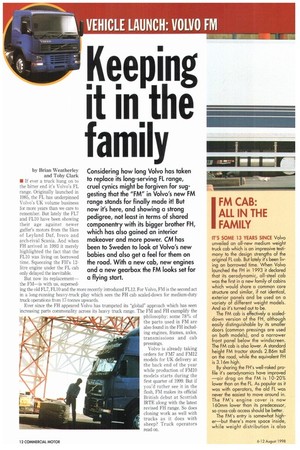
Page 15
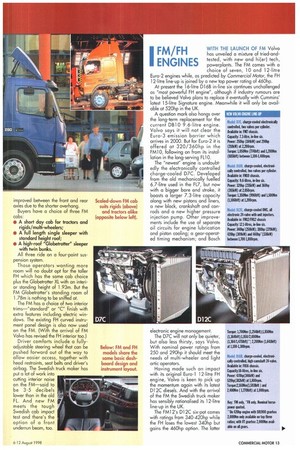
Page 16
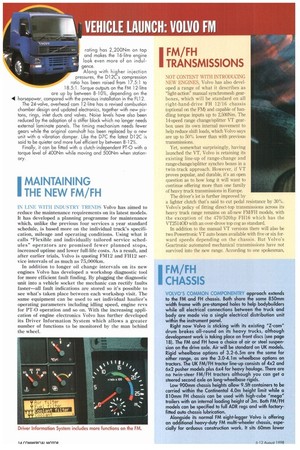
Page 17
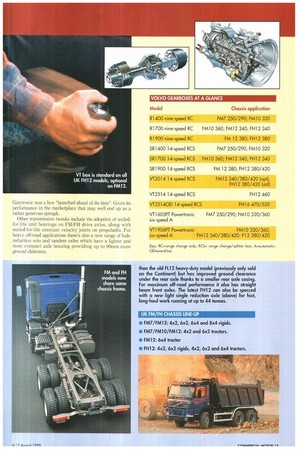
Page 18
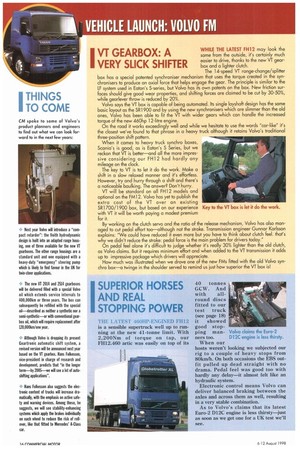
Page 19
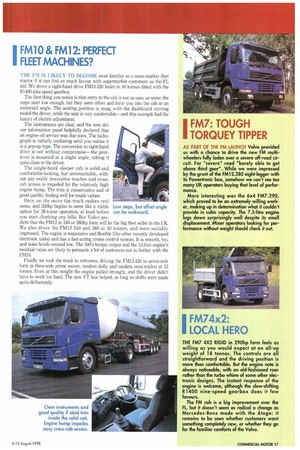
If you've noticed an error in this article please click here to report it so we can fix it.
Considering how long Volvo has taken to replace its long-serving FL range, cruel cynics might be forgiven for suggesting that the "FM" in Volvo's new FM range stands for finally made it! But now it's here, and showing a strong pedigree, not least in terms of shared componentry with its bigger brother FH, which has also gained an interior makeover and more power. CM has been to Sweden to look at Volvo's new babies and also get a feel for them on the road. With a new cab, new engines and a new gearbox the FM looks set for a flying start.
by Brian Weatherley and Toby Clark
• If ever a truck hung on to the hitter end it's Volvo's FL range. Originally launched in 1985, the FL has underpinned Volvo's UK volume business for more years than we care to remember. But lately the FL7 and FL10 have been showing their age against newer gaffer's motors from the likes of Leyland Daf, Iveco and arch-rival Scania. And when FH arrived in 1993 it merely highlighted the fact that the FL10 was living on borrowed time. Squeezing the FH's 12litre engine under the FL cab only delayed the inevitable.
But now its replacementthe FM—is with us, superseding the old FL7, FL10 and the more recently introduced FL12. For Volvo, FM is the second act in a long-running heavy-truck play which sees the FH cab scaled-down for medium-duty truck operations from 17-tonnes upwards.
Ever since the FH appeared Volvo has trumpeted increasing parts commonality across its heavy truck
its "global" approach which has seen range. The FM and FH exemplify the philosophy: some 78% of the parts used in FM are also found in the FH including engines, frames, axles, transmissions and cab pressings.
Volvo is already taking orders for FM7 and FM12 models for UK delivery at the back end of the year while production of FM10 models starts during the first quarter of 1999. But if you'd rather see it in the flesh, FM makes its official British debut at Scottish IRTE along with the latest revised FH range. So does cloning work as well with trucks as it does with sheep? Truck operators read on.
IFM CAB: ALL IN THE FAMILY IT'S SOME 13 YEARS SINCE Volvo unveiled an all-new medium weight truck cab which is an impressive testimony to the design strengths of the original FL cab. But lately it's been living on borrowed time. When Volvo launched the FH in 1993 it declared that its aerodynamic, all-steel cab was the first in a new family of cabins which would share a common core structure and similar, if not identical, exterior panels and be used on a variety of different weight models. And so it's turned out to be.
The FM cab is effectively a scaleddown version of the FH, although easily distinguishable by its smaller doors (common pressings are used on both models), and a narrower front panel below the windscreen. The FM cab is also lower. A standard height FM tractor stands 2.86m tall on the road, while the equivalent FH is 3.16m high. By sharing the FH's well-raked profile it's aerodynamics have improved —air drag on the FM is 10-20% lower than an the FL. As popular as it was with operators, the old FL was never the easiest to move around in. The FM's engine cover is now I60mm lower than its predecessor, so cross-cab access should be better.
The FM's entry is somewhat higher—but there's more space inside, while weight distribution is also
improved between the front and rear axles due to the shorter overhang. Buyers have a choice of three FM cabs: • A short day cab for tractors and rigids/multi-wheelers; • A full length single sleeper with standard height roof; • A high-roof "Globetrotter" sleeper with twin bunks.
All three ride on a four-point suspension system. Those operators wanting more room will no doubt opt for the taller FH which has the same cab choice plus the Globetrotter XL with an interior standing height of 1.93m. But the FM Globetrotter's standing room of 1.78m is nothing to be sniffed at. The FM has a choice of Iwo interior trims—"standard" or "C" finish with extra features including electric windows. The existing FH curved instrument panel design is also now used on the FM. (With the arrival of FM Volvo has revised the FH interior too.) Driver comforts include a fullyadjustable steering wheel that can be pushed forward out of the way to allow easier access, together with head restraints, seat belts and driver's airbag. The Swedish truck maker has put a lot of work into cutting interior noise on the FM—said to be 3-5 decibels lower than in the old FL. And new FM meets the tough Swedish cab impact test and there's the option of a front underrun beam, too.
I FM/FH
ENGINES
WITH THE LAUNCH OF FM Volvo has unveiled a mixture of tried-andtested, with new and hi(er) tech, powerplants. The FM comes with a choice of seven, 10 and 12-litre Euro-2 engines while, as predicted by Commercial Motor, the FH 12-litre line-up is joined by a new top power rating of 460hp. At present the 16-litre Dl 6B in-line six continues unchallenged as "most powerful FH engine", although if industry rumours are to be believed Volvo plans to replace it eventually with Cummins' latest 15-litre Signature engine. Meanwhile it will only be available at 520hp in the UK. A question mark also hangs over the long-term replacement for the current DB I 0 9.6-litre engine. Volvo says it will not clear the Euro-3 emission barrier which arrives in 2000. But for Euro-2 it is offered at 320/360hp in the FM10, following on from its installation in the long-serving FL10.
The "newest" engine is undoubtedly the electronically controlled charge-cooled D7C. Developed from the old mechanically fuelled 6.7-litre used in the FL7, but now with a bigger bore and stroke, it boasts a larger 7.3-litre capacity along with new pistons and liners, a new block, crankshaft and conrods and a new higher pressure injection pump. Other improvements include the use of separate oil circuits for engine lubrication and piston cooling; a gear-operated timing mechanism; and Bosch electronic engine management. The D7C will not only be quieter, but also less thirsty, says Volvo. With nominal power ratings from 250 and 290hp it should meet the needs of multi-wheeler and light artic operators. Having made such an impact with its original Euro-1 12-litre FH engine, Volvo is keen to pick up the momentum again with its latest Dl 2C diesels. And with the arrival of the FM the Swedish truck maker has sensibly rationalised its 12-litre line-up in the UK.
The FM12's DI 2C six-pot comes with ratings from 340-420hp while the FH loses the lowest 340hp but gains the 460hp option. The latter rating has 2,200Nm on tap and makes the 16-litre engine look even more of an indulgence.
Along with higher injection pressures, the D12C's compression ratio has been raised from 17.5:1 to 18.5:1. Torque outputs on the FM 12-litre are ln by between 8-10%, depending on the 41 horsepower, comparee with the previous installation in the al 2. The 24-valve, overhead cam 12-litre has a revised combustion chamber design and updated electronics, together with new pistons, rings, inlet ducts and valves. Noise levels have also been reduced by the adoption of a stiffer block which no longer needs external laminate panels. The timing mechanism needs fewer gears while the original camshaft has been replaced by a new unit with a vibration damper. Like the D7C the latest Dl 2C is said to be quieter and more fuel efficient by between 8-12%. Finally, it can be fitted with a clutch-independent PT-0 with a torque level of 400Nm while moving and 500Nm when stationcry.
1 MAINTAINING 1 THE NEW FM/FH
IN LINE WITH INDUSTRY TRENDS Volvo has aimed to reduce the maintenance requirements on its latest models. It has developed a planning progranune for maintenance which, unlike the previous four services a year standard schedule, is based more on the individual truck's specification, mileage and operating conditions. Using what it calls "Flexible and individually tailored service schedules" operators are promised fewer planned stops, increased uptime and lower full-life costs. As a result, and after earlier trials, Volvo is quoting FM12 and FH12 service intervals of as much as 75,000km.
In addition to longer oil change intervals on its new engines Volvo has developed a workshop diagnostic tool for more efficient fault finding. By plugging the diagnostic unit into a vehicle socket the mechanic can rectify faults faster—all fault indications are stored so it's possible to see what's taken place between each workshop visit. The same equipment can be used to set individual haulier's operating parameters including idling speed, engine revs for PT-0 operation and so on. With the increasing application of engine electronics Volvo has further developed its Driver Information System which allows a greater number of functions to be monitored by the man behind the wheel.
FM/FH I TRANSMISSIONS
NOT CONTENT WITH INTRODUCING NEW ENGINES, Volvo has also developed a range of what it describes as "light-action" manual synchromesh gearboxes, which will be standard on all right-hand-drive FH 12/16 chassis (optional on the FM) and capable of handling torque inputs up to 2,500Nm. The 14-speed range change/splitter VT gearbox uses its own internal movement to help reduce shift loads, which Volvo says are up to 50% lower than with previous transmissions.
Yet, somewhat surprisingly, having launched the VT, Volvo is retaining its existing line-up of range-change and range-change/splitter synchro boxes in a twin-track approach. However, if VT proves popular, and durable, it's an open question as to how long it will want to continue offering more than one family of heavy truck transmissions in Europe.
The driver's lot is further improved by a lighter clutch that's said to cut pedal resistance by 30%. Volvo's policy of fitting direct-top transmissions across its heavy truck range remains on all-new FM/FH models, with the exception of the 470/520hp FH16 which has the VT25140D with an over-drove top cog as standard.
In addition to the manual VT versions there will also be two Powertronic VT auto boxes available with five or six forward speeds depending on the chassis. But Volvo's Geartronic automated mechanical transmissions have not survived into the new range, According to one spokesman,
Geartronic was a box "launched ahead of its time". Given its performance in the marketplace that may well end up as a rather generous epitaph.
Other transmission tweaks include the adoption of sealedfor-life unit bearings on FM/FH drive axles, along with sealed-for-life constant velocity joints on propshafts. For heavy off-road applications there's also a new range of hub. reduction solo and tandem axles which have a lighter and more compact axle housing providing up to 90mm more ground clearance.
FM/FH I CHASSIS
VOLVO'S COMMON COMPONFNTP approach extends to the FM and FH chassis. Both share the same 850mm width frame with pre-stamped holes to help bodybuilders while all electrical connections between the truck and body are made via a single electrical distribution unit within the instrument panel. Right now Volvo is sticking with its existing "Z-cam" drum brakes all-round on its heavy trucks, although development work is taking place on front discs (see page 18). The FM and FH have a choice of air or steel suspension on the drive axle. Air will be standard on UK models. Rigid wheelbase options of 3.2-6.5m are the same for either range, as are the 3.0-4.1m wheelbase options on tractors. The UK FM/FH tractor line-up consists of 4x2 and 6x2 pusher models plus 6x4 for heavy haulage. There are no twin-steer FM/FH tractors although you can get a steered second axle on long-wheelbase rigids. Low 900mm chassis heights allow 9.5ft containers to be carried within the Continental 4.0m height limit while a 810mm FH chassis can be used with high-cube "mega" trailers with an internal loading height of 3m. Both FM/FH models can be specified to full ADR regs and with factoryfitted auto chassis lubrication.
Alongside its normal FM eight-legger Volvo is offering an additional heavy-duty FM multi-wheeler chassis, especially for arduous construction work. It sits 60mm lower
than the old F112 heavy-duty model (previously only sold on the Continent) but has improved ground clearance under the rear axle thanks to a smaller rear axle casing. For maximum off-road performance it also has straight beam front axles. The latest FH12 can also be specced with a new light single reduction axle (above) for fast, long-haul work running at up to 44 tonnes.
Nav VOLVO ENGINE UNE-OP mom: t1il, charge-cooled electronically controlled, two valves per cylinder. Available in: FM? chassis,
Capacity: 7.3-litre, in-line six.
Power: 250hp (184kW) and 200hp (210101) at 2100rpm.
Torque: 1,050Nm (774Ih0t) and 1,2000m (88511ift) between 1,100-11,400rprn.
charge-cooled, electronically controlled, two valves per cylinder. Available in: FM10 chassis.
Capacity: 9.6-litres, in-line six.
Power: 320hp (2351611) and 360hp (2651ir at 2,0500m.
Torque: 1,35{INm (096Ibft) and 1,5000m (1,106Ibft) at 1,200rpm.
Model: 012l: charge-cooled OliC, all electronic 24-valve with unit injectors. Available in: FM12/F}112 chassis Capacity: 12.1-litres, in-fine six. Power 340hif(250kW): 380hp (279kW); 4201ip (309101) and 460hp—(338kW) between 1,700 1,800rpm.
Torque:1,700M (1,2541b0t);1,850Nin (1,3641hft);1,850/2.000Nm (1,364/1,47511)Fr: 2,2000m (1,64111ift) at 1,100-1,30Orpm.
charge-cooled, efectroni cally-controlied. higth-camshaft 24-valve. Available in: FHI6 chassis. Capacity:16-iiires, in-line six. Power: 470hp(346kW) and 52(01082M) at 1.800rpm. Torque:2,160Nm(1,5931bft ) and 2,400Nm 1,7713113ft) at 1,000rpm.
Key: 'FM only, IN only. Nominal horsepower quoted.
On 420hp engjne with SR1900 gearbox 2,000Nm only available on top three ratios: with VT gearbox 2,0000m available on al gears.
VOLVO GEARBOXES AT A GLANCE Model Chassis application
R 1 400 nine-speed RC FM7 250/290; FM10 320 R1700 nine-speed RC FM10 360; FM12 340; FH12 340 R 1 900 nine-speed RC FM 12 380; FH12 380 SR1400 1 4-speed RCS FM7 250/290, FM10 320
SR1700 14-speed RCS FM10 360; FM12 340; FH12 340
SR 900 14-speed RCS FM I 2 380; FH12 380/420 V12014 14-speed RCS FM12 340/380/420 (opt);
FH12 380/420 (stc)
VT2514 1 4-speed RCS
FH12 460
VT25140D 14 speed RCS FH16 470/520 VT1605PT Power-tronc FM7 250/290; FM10 320/360 s;x-speed A VT1906PT Powerfronic FM10 320/360;
six-speed A FM12 340/380/420; F12 380/420
Key; RC.range change only; RCS= range change/splilier box; A=oulomatic:
OD=overdrive.
Iii IA iITMMU lIJ
• FM7/FM12: 4x2, 6x2, 6x4 and 8x4 rigids.
• FM7/FM10/FM12: 4x2 and 6x2 tractors.
• FM12: 6x4 tractor • FH12: 4x2, 6x2 rigids, 4x2, 6x2 and 6x4 tractors.
I THINGS TO COME
CM spoke to some of Volvo's product planners and engineers to find out what we can look forward to in the next few years: Next year Volvo will introduce a "compact retarder": the Voith hydrodynamic design is built into an adapted range housing, one of three available for the new VT gearboxes. The other range housings are a standard unit and one equipped with a heavy-duty "emergency" steering pump which is likely to find favour in the UK for twin-steer applications.
The new VT 2014 and 2514 gearboxes will be delivered filled with a special Volvo oil which extends service intervals to 400.000km or three years. The box can subsequently be refilled with the special oil--described as neither a synthetic nor a semi-synthetic—or with conventional gearbox oil, which will require replacement after 120,000kmlone year.
Although Volvo is dropping its present Ceartronic automatic shift system, a revised version will be announced next year based on the VT gearbox. Hans Folkesson, vice-president in charge of research and development, predicts that "in the longer term—by 2005—we will see a lot of autoshifting applications".
Hans Folkesson also suggests the electronic content of trucks will increase dramatically, with the emphasis on active safety and warning devices. Among these, he suggests, we will see stability-enhancing systems which apply the brakes individually on each wheel to reduce the risk of rollover, like that fitted to Mercedes' A-Class
VT GEARBOX: A
VERY SLICK SHIFTER easier to drive, thanks to the new VT gear
box and a lighter clutch.
WHILE THE LATEST FH12 may look the same from the outside, it's certainly much The 14-speed VT range-change/splitter box has a special patented synchroniser mechanism that uses the torque created in the synchronisers to produce an axial force that helps engage the gear. The principle is similar to the LF system used in Eaton's S-series, but Volvo has its own patents on the box. New friction surfaces should give good wear properties, and shifting forces are claimed to be cut by 30-50%, while gearlever throw is reduced by 20%. Volvo says the VT box is capable of being automated. Its single layshaft design has the same basic layout as the SR1900 and by using the new synchronisers which ore slimmer than the old ones, Volvo has been able to fit the VT with wider gears which can handle the increased torque of the new 460hp 1 2-litre engine.
On the road it works exceedingly well and while we hesitate to use the words "car-like" it's the closest we've found to that phrase in a heavy truck although it retains Volvo's traditional three-position shift pattern.
When it comes to heavy truck synchro boxes, 5cania's is good, as is Eaton's S Series, but we reckon that VT is better—and all the more impressive considering our FH12 had hardly any mileage on the clock. The key to VT is to let it do the work. Make a shift in a slow relaxed manner and it's effortless. However, try and hurry through a shift and there's a noticeable baulking. The answer? Don't hurry. VT will be standard on all FH12 models and optional on the FM] 2. Volvo has yet to publish the extra cost of the VT over an existing SR1700/1900 box, but based on our experience with VT it will be worth paying a modest premium for it.
By working on the clutch servo and the ratio of the release mechanism, Volvo has also managed to cut pedal effort too—although not the stroke. Transmission engineer Gunnar Karlsson explains: "We could have reduced it even more but you have to think about clutch feel. that's why we didn't reduce the stroke: pedal force is the main problem for drivers today." On pedal feel alone it's difficult to judge whether it's really 30% lighter than the old clutch,
as Volvo claims. But it requires minimum effort and when added to the VT transmission it adds up to impressive package which drivers will appreciate. How much was illustrated when we drove one of the new FMs fitted with the old Volvo synchro box—a twinge in the shoulder served to remind us just how superior the VT box is!
Key to the VT box is let it do the work.
ISUPERIOR HORSES AND REAL STOPPING POWER THE LATEST •16011P-ENGINED FH12 is a sensible supertruck well up to running at the new 41-tonne limit. With 2,200Nm of torque on tap, our FH12.460 artic was easily on top of its 40 tonnes GCW. And with allround discs fitted to our test truck (see page 18) it showed good stopping manners too.
When our hosts weren't looking we subjected our rig to a couple of heavy stops from 80km/h. On both occasions the EBS outfit pulled up dead straight with no drama. Pedal feel was good too with hardly any delay—it almost felt like an hydraulic system.
Electronic control means Volvo can deliver balanced braking between the axles and across them as well, resulting in a very stable combination.
As to Volvo's claims that its latest Euro-2 D12C engine is less thirsty—just as soon as we get one for a UK test we'll see.
I FM10 & FM12: PERFECT FLEET MACHINES?
THE FM IS LIKELY TO BECOME most familiar as a mass-market fleet tractor if it can find as much favour with supermarket customers as the FL did. We drove a right-hand drive FM10.320 laden to 40 tonnes fitted with the R1400 nine-speed gearbox.
The first thing you notice is that entry to the cab is not as easy as some: the steps start low enough, but they seem offset and force you into the cab at an awkward angle. The seating position is snug, with the dashboard curving round the driver, while the seat is very comfortable—and this example had the luxury of electric adjustment.
The instruments are clear, and the new driver information panel helpfully declared that an engine oil service was due soon. The tachograph is initially confusing until you realise it is a pop-up type. The conversion to right-hand drive is not without compromise—the gearlever is mounted at a slight angle, taking it quite close to the driver.
The single-bunk sleeper cab is solid and comfortable-looking, but unremarkable, without any really innovative touches and crosscab access is impeded by the relatively high engine hump. The trim is conservative and of good quality, boding well for resale values.
Once on the move the truck makes real sense, and 320hp begins to seem like a viable option for 38-tonne operation, at least before you start climbing any hills. But Volvo predicts that the FM12 in 340 or 380hp form will be the big fleet seller in the UK. We also drove the FM12 340 and 380 at 40 tonnes, and were suitably impressed. The engine is responsive and flexible (like other recently developed electronic units) and has a fast-acting cruise control system. It is smooth, too, and noise levels seemed low. The 340's torque output and the 12-litre engine's residual value are likely to persuade a lot of customers not to bother with the FM10.
Finally we took the truck to extremes, driving the FM12.420 in seven-axle form (a three-axle prime mover, tandem dolly and tandem semi-trailer) at 53 tonnes. Even at this weight the engine pulled strongly, and the driver didn't have to work too hard. The new VT box helped, as long as shifts were made quite deliberately. Low steps, but offset angle can be awkward.
1 FM7: TOUGH I TORQUEY TIPPER
AS PART OF THE FM LAUNCH Volvo provided us with a chance to drive the new FM multiwheelers fully laden over a severe off-road circuit. For "severe" read "barely able to get above third gear". While we were impressed by the grunt of the FM12.380 eight-legger with its Powertronic box, somehow we can't see too many UK operators buying that level of performance.
More interesting was the 6x4 FM7.290, which proved to be an extremely willing worker, making up in determination what it couldn't provide in cubic capacity. The 7.3-litre engine lugs down surprisingly well despite its small displacement. Mixer operators looking for performance without weight should check it out.
FM74x2: I LOCAL HERO
THE FM7 4X2 RIGID in 290hp form feels as willing as you would expect at an all-up. weight of 18 tonnes. The controls are all straightforward and the driving position is more than comfortable. But the engine note is always noticeable, with an old-fashioned roar rather than the turbo whine of some other electronic designs. The instant response of the engine is welcome, although the slow-shifting R1400 nine-speed gearbox does it few favours.
The FM cab is a big improvement over the FL, but it doesn't seem as radical a change as Mercedes-Benz made with the Atego: it remains to be seen whether customers want something completely new, or whether they go for the familiar comforts of the Volvo.












































































































